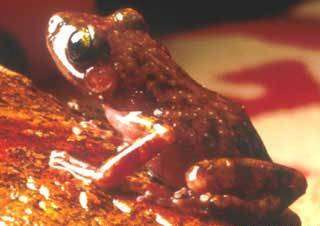Leptodactylidae
The southern frogs form the Leptodactylidae, a name that comes from Greek meaning a bird or other animal having slender toes. They are a diverse family of frogs that most likely diverged from other hyloids during the Cretaceous.[1] The family has undergone major taxonomic revisions in recent years, including the reclassification of the former subfamily Eleutherodactylinae into its own family the Eleutherodactylidae; the Leptodactylidae now number 206 species in 15 genera distributed throughout Mexico, the Caribbean, and Central and South America.[2] The family includes terrestrial, burrowing, aquatic, and arboreal members, inhabiting a wide range of habitats.[3]
| Leptodactylidae | |
|---|---|
 | |
| Eleutherodactylus guttilatus | |
| Scientific classification | |
| Kingdom: | Animalia |
| Phylum: | Chordata |
| Class: | Amphibia |
| Order: | Anura |
| Clade: | Hyloidea |
| Family: | Leptodactylidae Werner, 1896 |
| Subfamilies | |
| |
| Distribution of Leptodactylidae (in black) | |
Several of the genera within the Leptodactylidae lay their eggs in foam nests. These can be in crevices, on the surface of water, or on forest floors. These foam nests are some of the most varied among frogs. When eggs hatch in nests on the forest floor, the tadpoles remain within the nest, without eating, until metamorphosis.
Classification
As of Dec, 2019, the Amphibian Species of the World classifys the following genera in the family Leptodactylidae:[4]
- Subfamily Leiuperinae Bonaparte, 1850 (90 species)
- Edalorhina Jiménez de la Espada, 1870
- Engystomops Jiménez de la Espada, 1872
- Physalaemus Fitzinger, 1826
- Pleurodema Tschudi, 1838
- Pseudopaludicola Miranda-Ribeiro, 1926
- Subfamily Leptodactylinae Werner, 1896 (1838) (96 species)
- Adenomera Steindachner, 1867
- Hydrolaetare Gallardo, 1963
- Leptodactylus Fitzinger, 1826
- Lithodytes Fitzinger, 1843
- Subfamily Paratelmatobiinae Ohler and Dubois, 2012 (13 species)
- Crossodactylodes Cochran, 1938
- Paratelmatobius Lutz and Carvalho, 1958
- Rupirana Heyer, 1999
- Scythrophrys Lynch, 1971
- Incertae sedis
- "Leptodactylus" ochraceus Lutz, 1930
References
- Heinicke, M.P., W.E. Duellman & S.B. Hedges (2007). "Major Caribbean and Central American frog faunas originated by ancient oceanic dispersal". Proc. Natl. Acad. Sci. 104 (24): 10092–7. doi:10.1073/pnas.0611051104. PMC 1891260. PMID 17548823.CS1 maint: multiple names: authors list (link)
- "AmphibiaWeb: Information on Amphibian Biology and Conservation". University of California, Berkeley, CA. Retrieved 2007-06-17.
- Zweifel, Richard G. (1998). Cogger, H.G.; Zweifel, R.G. (eds.). Encyclopedia of Reptiles and Amphibians. San Diego: Academic Press. pp. 89–90. ISBN 0-12-178560-2.
- Frost, Darrel R. (2015). "Leptodactylidae Werner, 1896 (1838)". Amphibian Species of the World: an Online Reference. Version 6.0. American Museum of Natural History. Retrieved 28 August 2015.